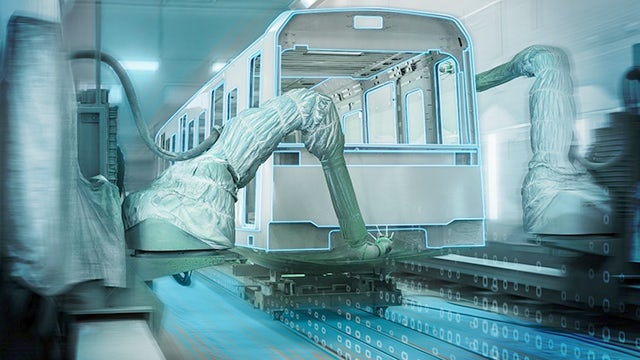Siemens Mobility uses Opcenter APS to improve productivity of railcar body surface treatment center
Increasing efficiency by integrating digital scheduling
Siemens Mobility
Siemens Mobility has been a leader for seamless, sustainable, reliable, and secure transport solutions for more than 160 years. The core business areas are rolling stock, rail automation and electrification, turnkey systems, intelligent traffic systems, and related services.
http://www.mobility.siemens.com- Headquarters:
- Vienna, Austria
- Products:
- Opcenter, Opcenter APS
- Industry Sector:
- Automotive & transportation
Through reliable and realistic scheduling, we reduce the proportion of non-value-added work by up to 60 percent and the lead time by 10 percent.
Siemens Mobility, Austria
Railcar body surface treatments must be expedited
The surface production facility of the Siemens Mobility, Austria plant in Vienna, carries out all coating processes for manufactured railcar bodies. This includes sandblasting, cementing, grinding and priming, and top coating. In the transfer table area, railcar bodies are transported to a processing cabin near a conveyor system.
Today, painting and sanding processes offer a high degree of automation due to robot-assisted production systems. However, with high demand, Siemens Mobility must expedite throughput time of railcar body surface treatments. Currently, surface treatments take around 15 days. “Our processes show a high degree of agility, you can’t schedule days in advance!” says Herbert Dippold, head of surface treatments at Siemens Mobility. Surface treatments form a bottleneck in the manufacturing process, and delays in this area can lead to late delivery. Optimizing the 29-step process each railcar body goes through is critical.
Models for data processing layers must be expanded
This digitization gap in order processing is typically bridged at the shop floor via manual, ad hoc actions. In order to minimize these actions, the digital manufacturing technologies (DMT) department at the Siemens headquarters in Munich and the local digitization team at Siemens Mobility have started the Integrated Digital Scheduling project.
The central point of this project is the direct networking of different planning levels with order fulfillment levels in the factory. Level zero is for product data management (PDM), which oversees all development data, including the parts list. Level one handles enterprise resource planning (ERP) for orders including purchasing and warehousing. Level two conducts scheduling. The factory area (shop floor) begins on level three.

Digital identification of the products in the value chain
The DMT experts at Siemens, Munich must develop a concept for integrating the existing processes in the project planning tool and the ERP with the factory levels. This enables a real-time reaction in the factory, having an immediate effect on order planning and scheduling. Siegfried Indinger is the head of digitization at Siemens Mobility. The digital factory team is in charge of supplementing these ideas with local experience, then implementing and validating them directly on site. The initial step in this process is identifying the serial number of the railcar bodies being processed.
For Oliver Lohse and Michael Meyer-Hentschel, research and development (R&D) engineers from the DMT team, the level of detail in the ERP work processes is a fundamental component for seamlessly scheduling production orders. All scheduling-relevant work processes must be included in the work plan to implement flow control.
Patrick Solea, project manager of the digital factory, and Peter Smolik, a data analyst from Siemens Mobility, revised a sample work plan with Christian Giller, an industrial engineer at Siemens Mobility to reflect real processing. An essential component for scheduling is gaining feedback from the activities in real-time. This allows deviations from the planning status to be quickly recognized and counteracted.
Digital scheduling with the support of Opcenter APS
Preparing the data basis and interfacing with the existing information technology (IT) structure, establishes the full potential of the digitization project. The introduction of Opcenter™ Advanced Planning and Scheduling (APS) software, which is a part of the Siemens Xcelerator business platform of software, hardware and services, integrates scheduling into the entire digital production process. Siemens DMT experts led by Peter Robl at Siemens Technology, Germany, support their colleagues at Siemens Mobility with detailed first-hand process and IT project experience. The DMT team emphasizes data preparation. “Planning includes adapting the work operation scheduling to Opcenter APS logic, recording all scheduling-relevant work operations in the ERP work plan, maintaining a complete and up-to-date warehouse data collection, providing reliable, real-time feedback when production steps are complete, and introducing resource management and planning (production resources and personnel)”, explains Robl. High data quality, increases scheduling quality. “Thanks to the support of the DMT experts, the planning system was successfully integrated into the existing process and system landscape, so we can make the best use of Opcenter APS capabilities,” says Solea. “The use of the production planning software enables faster and more precise, detailed and capacity planning for all production resources.”
The introduction of the new level, digital production scheduling (DPS) proved to be necessary. Opcenter APS offers the capability of accurate digital scheduling. Several requirements are needed to operate this software tool appropriately. The warehouse data must be complete and up-to-date, the work plan times must be correct, the feedback from the production process must be reliable, and all the necessary resources must be prepared. Solea strongly emphasizes the importance of making sure all essential materials are available prior to beginning a production order, which prevents delivery delays in the end.
For Smolik, reliable data is “the most logical thing in the world.” However, in many cases, it is outdated, incorrect, or non-existent. This means the data cannot be processed for the consumer. In some cases, the data is more “trash” than “raw”, says Meyer-Hentschel. In the integrated digital termination (IDT) project, initial data cleaning is necessary to gain the user’s trust.
Opcenter APS is integrated with the ERP and personnel planning tool to make all scheduling-relevant data available. As a result of the activities in the surface pilot area, all available production resources can be efficiently scheduled. Changes or faults are reported back in real-time and regularly taken into account in scheduling.
Smolik and Gerhard Wagner, production planner and Opcenter APS operator at Siemens Mobility, use Opcenter APS in the production planning department to revise the work plans with a developed template and distribute the solution over all workstations in the surface area.
As a next step, the DMT team at Siemens, Munich is integrating throughput control of the railcar bodies for the 32 work steps. The challenge is coordinating this data with the process and drying times in this department.
A variety of rules must be considered when railcar bodies pass through the department. This is dependent on the drying times of the individual paint layers, regular acceptance dates with quality assurance and the respective customer.
According to Lohse, another step towards digitization is developing a fault management tool. This new tool uses artificial intelligence (AI) methods. They enable problems in the process flow to be balanced. The DMT team at Siemens, Munich is working on AI solutions that recognize machine-related malfunctions and interruptions triggered by personnel availability and climatic influences (for example, humidity).

Benefits
Michael Leisgang, plant manager at Siemens Mobility, states: “Through reliable and realistic scheduling, we reduce the proportion of non-value-added work by up to 60 percent and the lead time by 10 percent.” Due to more precise schedules, non-conformance costs are reduced. The payback period is around two years. The high quality of the source data enables improvements in productivity and efficiency in follow-up projects. “The integration of digital scheduling represents a footprint for other areas such as the body shop, which now needs to be pursued further,” states Idinge.
The use of the production planning software enables faster and more precise, detailed and capacity planning for all production resources.
Siemens Mobility, Austria
